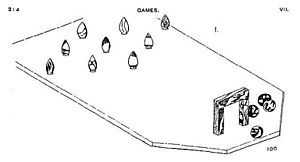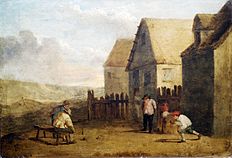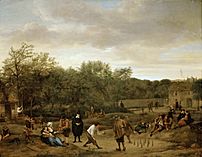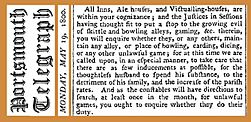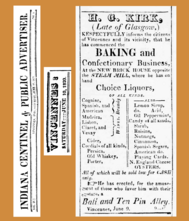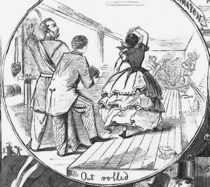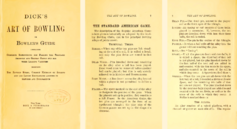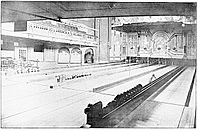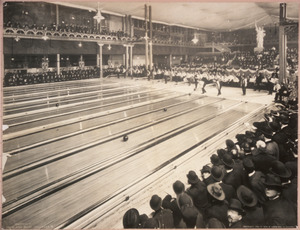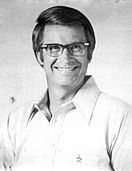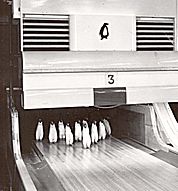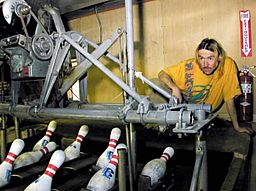Bowling facts for kids

Bowling is a fun sport where people roll a heavy ball. Long ago, it started with people rolling heavy iron balls. There are two main types of bowling. One type is like lawn bowling, where you roll a ball close to a target or try to knock away another player's ball.
The most common type today is where you roll a ball down a bowling lane to knock down wooden bowling pins. This is often called "ten-pin bowling," or just "bowling." Some people play with smaller pins, called "duck pins" or "candle pins," which have slightly different rules.
Contents
Ten-pin Bowling
The usual bowling ball has three holes for your fingers and thumb. You swing the ball and let it roll down the lane, trying to knock down all ten wooden pins. If you don't roll it just right, the ball might not hit all the pins or could roll into the gutter and miss them all. Players take turns rolling their ball to see who gets the highest score.
How is Ten-pin Bowling Scored?
Ten-pin bowling scores can be from 0 to 300. Players get 10 chances, called "frames," to knock down pins. In each frame, you can try to knock down all the pins up to two times.
- If you don't knock down all pins after two tries, you get points for each pin you knocked down (up to 9 points).
- If you knock down all pins on your first try, it's called a strike. A strike is worth 10 points, plus the number of pins you knock down on your next two rolls.
- If you knock down all remaining pins on your second try, it's called a spare. A spare is worth 10 points, plus the number of pins you knock down on your next roll.
If you get a strike or spare in your 10th (last) frame, you get to roll the ball one or two more times to earn your bonus points.
History of Bowling
Ancient Beginnings
Bowling is a very old sport! The earliest signs of bowling come from ancient Egypt. Drawings of bowling were found in a royal Egyptian tomb from around 3200 BC. Small pins and balls were even found in an Egyptian child's grave from the same time. Some ancient bowling balls were made from grain husks covered in leather, while others were made of porcelain.
About 2,000 years ago, in the Roman Empire, Roman soldiers played a similar game. They would toss stone objects close to other stone objects. This game eventually became Italian Bocce, which is a type of outdoor bowling.
Around 400 AD, bowling started in Germany as a religious activity. People would roll a rock at a club (called a kegel) to show they were getting rid of bad things. That's why bowlers were sometimes called "keglers."
Medieval Times and Beyond
In 1299, the oldest known bowling green (a grassy area for target bowling) was built in Southampton, England. It's still used today!
In 1366, bowling was first officially mentioned in England. King Edward III even banned it because people were playing bowling instead of practicing archery!
By the 15th to 17th centuries, lawn bowling spread from Germany to other parts of Europe. In 1455, bowling lanes in London were covered with roofs, so people could play in any weather. In Germany, these covered lanes were called kegelbahns and were often found near taverns.
Modern Bowling Takes Shape
16th to 18th Centuries
English King Henry VIII loved bowling. In 1511, he made it illegal for common people to bowl and added a tax for private lanes, so only wealthy people could play. Another law in 1541 (which was later removed) stopped workers from bowling except at Christmas, and only if their boss was there. King Henry VIII even had outdoor bowling lanes built at his new home, Whitehall Palace.
Martin Luther, who started the Protestant Reformation, helped set the number of pins at nine (it used to vary a lot). He had a bowling lane built next to his home for his children and sometimes bowled himself.
A famous story says that on July 19, 1588, English Vice-Admiral Sir Francis Drake was playing bowls when he heard the Spanish Armada was coming. He supposedly said, "We have time enough to finish the game and beat the Spaniards too."
In 1609, explorer Henry Hudson brought a form of lawn bowling to New Amsterdam (which is now New York City).
19th Century Developments
A painting from around 1810 in England shows someone bowling with ten pins arranged in a triangle. This was before ten-pin bowling was thought to have appeared in the United States.
In 1819, American writer Washington Irving mentioned nine-pin bowling in his story "Rip Van Winkle". By the late 1830s, hotels in New York had bowling alleys.
In 1846, the oldest surviving bowling lanes in the United States were built at Roseland Cottage in Woodstock, Connecticut.
When many German immigrants came to the U.S. in the mid-1800s, they brought their love for bowling with them. By the late 1800s, New York City became a major center for bowling.
In 1875, the National Bowling Association (NBA) was formed in New York City to create standard rules for ten-pin bowling. They set the ball size and the distance to the pins. This group was later replaced by the American Bowling Congress in 1895.
In 1880, Candlepin Bowling was invented in Massachusetts. In the early 1890s, Duckpin bowling was invented in Boston.
On September 9, 1895, the modern rules for ten-pin bowling were set in New York City by the new American Bowling Congress (ABC). They changed the scoring system and set the maximum ball weight at 16 pounds.
20th Century Growth
In 1908, the oldest surviving bowling alley for ten-pin bowling opened in Milwaukee, Wisconsin, in the basement of the Holler House tavern.
The first ten-pin bowling alley in Europe was built in Sweden in 1909. After World War II, ten-pin bowling became popular in Great Britain when many lanes were built on U.S. military bases.
From 1920 to 1933, changes in U.S. laws meant bowling alleys became separate from places that sold alcohol. This helped bowling become more of a family game and encouraged more women to play.
In 1926, the International Bowling Association (IBA) was formed by the United States, Sweden, Germany, Netherlands, and Finland. They held world championships.
In 1950, the "Golden Age of Ten-Pin Bowling" began. Professional bowlers earned a lot of money, similar to baseball or football players. This lasted until the late 1970s.
In 1952, American Machine and Foundry (AMF) started selling automatic Pinsetter machines. These machines set up the pins automatically, which meant bowling became much more popular. The 1950s became known as the "Decade of the Bowler."
In 1958, the Professional Bowlers Association (PBA) was started by 33 famous bowlers. The PBA grew to have about 4,300 members in 14 countries. In 1975, Earl Anthony became the first PBA member to earn $100,000 in a year.
On November 28, 1960, Don Carter won the first PBA Championship.
On January 27, 1962, ABC Television started showing PBA Tour events on Saturday afternoons. This helped make bowling very popular on TV until the early 1980s.
In 1963, the Fifth FIQ World Bowling Championships were held in Mexico City. It was the first time women competed, and Team USA won many medals.
In 1964, "Mr. Bowling" Don Carter became the first athlete to sign a $1 million endorsement deal.
In 1988, ten-pin bowling was a demonstration sport at the 1988 Summer Olympics in Seoul, South Korea. In 1991, it became an international medal sport at the Pan American Games.
In the early 1990s, new types of bowling balls (resin balls) were introduced. This caused the number of perfect 300 scores to increase by 20%.
On February 2, 1997, Jeremy Sonnenfeld bowled the first officially recognized 900 series (three perfect 300 games in a row). He became known as "Mr. 900."
21st Century Bowling
On March 31, 2004, Missy Bellinder (later Parkin) became the first female member of the PBA. One year later, Liz Johnson became the first woman to reach the televised final round of a PBA Tour event.
On January 24, 2010, Kelly Kulick became the first woman to win the PBA Tournament of Champions, which is a major PBA event.
In 2013, the PBA League was started. It has eight teams of five players, and they have an annual draft.
In 2015, the Professional Women's Bowling Association (PWBA) was brought back after being closed for 12 years.
Images for kids
-
Bowling balls with their insides shown, at the International Bowling Museum.
See also
 In Spanish: Bolos para niños
In Spanish: Bolos para niños



